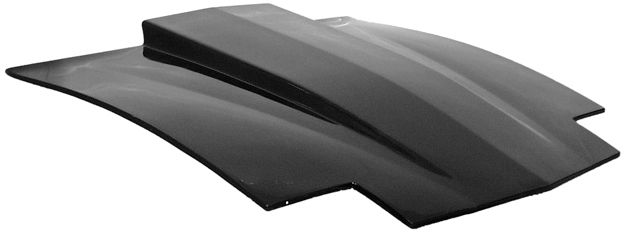Ram Air, Cowl Induction, and Air Grabber are among the phrases that have been emblazoned on the hoods of some of the 60’s and 70’s most feared muscle cars; phrases that refer to the induction of cold, outside air into the engine. Although a substantial amount of marketing was involved in the development of the phrases, the performance benefits of hood scoops are real.
Some of the first production cars fitted with functional hood scoops weren’t early American muscle cars, but actually post-war European sports cars including the 1949 Ferrari 166 M Barchetta and Healey Silverstone. The 1952 Mercury was among the first American cars fitted with a hood scoop. Other domestic manufacturers followed in the ensuing years and by the 1960’s, many of the era’s muscle cars sported some type of hood scoop. The auto manufacturers truly capitalized on both the marketing aspects and performance benefits.
Other than bolting on a set of performance exhaust headers, adding a hood scoop is one of the most cost-effective performance methods to increase horsepower. When an effectively designed hood scoop is used, outside air is forced into the air intake, air which up to 50°F cooler than air in the engine compartment. Cold air is denser and includes a higher percentage of oxygen compared to warm air, resulting in improved engine combustion and added horsepower. As road speeds increase, air speed and pressure increase, providing increasingly greater airflow. The only drawback of a hood scoop is the added exposure to the elements, however, most hood scoops include drain provisions in the air cleaner assembly to prevent water from entering the engine. There are a number of hood scoop variations including raised hood scoops, “shaker” hoods, N.A.C.A. ducts, and cowl induction hoods.
A wide variety of performance cars have sported raised hood scoops over the years including the Dodge Challenger, Ford Mustang, and Pontiac Trans Am. One method of adding a raised hood scoop is to use an OEM-style fiberglass bolt-on replacement hood from an aftermarket supplier such as Harwood Industries (Tyler, TX). A bit of research is often required for proper fit. For example, any 1998-2002 Pontiac Firebird may be converted to a raised hood scoop by simply installing a 1998-2002 Trans Am hood (Harwood B-20302). Harwood also offers bolt-on hoods with raised scoops for 1993-97 Trans Ams (B-20202) and 2005-2009 Ford Mustangs (B-26608). A high-flow cold air box, available from a variety of sources including K&N and SLP Performance Parts, may be added to maximize the benefits of hood installation.

Large aftermarket-style hood scoops, available through Allstar Performance (Watervliet, MI), Harwood Industries, and K&N Engineering, are effective in funneling cold air into the engine, however, they should be avoided for street-driven applications due to obstructed vision. These types of scoops are designed to be bonded or bolted on to the existing hood. Regardless of size or shape, the hood scoop should be used in conjunction with an air pan (Moroso 65950/65960 or Allstar Performance 26100/26101) or specialized air cleaner that includes a foam seal so that the incoming air is isolated from the engine compartment once the hood is closed. An air filter should also be in place for maximum engine protection. Drag race-only applications may be run without a filter when maximum performance is desired, but a protective screen (Allstar Performance 22260-22273) should be mounted underneath the scoop to prevent rocks and debris from entering the engine.
A “shaker” hood is very similar to a traditional hood scoop, however, the scoop is mounted directly to the air cleaner and protrudes through the hood, creating a “shaker” effect with a running engine. “Shaker” hoods were popular on several performance cars in the late 1960’s and 70’s including the 1969 Mustang Mach 1 428CJ, 1970-71 Plymouth ‘Cuda, and 1973-79 Pontiac Trans Am. The “shaker” hood was also used as recently as 2004 on the Ford Mustang and may be having a resurgence of sorts with Steeda Autosports (Pompano Beach, FL) and Ford Racing (Dearborn, MI) offering “shaker” hood scoop kits for late model Mustangs.
The N.A.C.A. (National Advisory Committee for Aeronautics) duct is a submerged design scoop that was originally developed for jet aircraft in 1945. It mounts just below the surface of the body with a gently sloped ramp and curved walls, creating less aerodynamic drag when compared to traditional raised scoops. N.A.C.A. ducts were featured on the 1969-70 Shelby Mustangs and remain popular today in the import market.
Cowl induction was made popular by Chevrolet on the 1969 Camaro Z28 and 1970-72 Chevelle SS. The principle of cowl induction is to place the scoop inlet at the rear of the hood, facing the base of the windshield, recognized by air flow experts as a high-pressure area. A variety of reproduction steel and aftermarket fiberglass cowl induction units are available from a number of sources. Harwood Industries offers fiberglass cowl induction hoods in bolt-on or lift-off versions for not only Camaros and Chevelles, but also for Novas, Monte Carlos, Firebirds, Mustangs, and popular trucks.

There have been other methods of adding cold air to performance engines over the years. In 1964, Ford deleted the inner headlights on the drag race-only Thunderbolt, using large ducts in their place that fed a special air cleaner to force cold air into the engine. The system was ideal for adding more horsepower to an already potent package, but not very practical for everyday street duty. Oldsmobile experimented as well with some neat, under-bumper scoops beginning in 1968 on the 4-4-2 W-30. The scoops were effective in boosting performance, but weren’t very “curb friendly” and were discontinued after the 1969 model year.